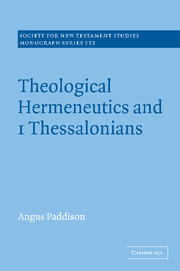Book contents
- Frontmatter
- Contents
- Foreword
- Preface
- List of abbreviations and notes about citation
- Introduction
- Part I The critical task
- Part II An exploration of some pre-modern readings of 1 Thessalonians
- 2 Thomas Aquinas and 1 Thessalonians
- 3 John Calvin and 1 Thessalonians
- 4 Conclusion to Part II
- Part III A proposed reading of 1 Thessalonians
- Conclusion
- Bibliography
- Index of Biblical references
- Index of authors
- Index of subjects
4 - Conclusion to Part II
Published online by Cambridge University Press: 02 November 2009
- Frontmatter
- Contents
- Foreword
- Preface
- List of abbreviations and notes about citation
- Introduction
- Part I The critical task
- Part II An exploration of some pre-modern readings of 1 Thessalonians
- 2 Thomas Aquinas and 1 Thessalonians
- 3 John Calvin and 1 Thessalonians
- 4 Conclusion to Part II
- Part III A proposed reading of 1 Thessalonians
- Conclusion
- Bibliography
- Index of Biblical references
- Index of authors
- Index of subjects
Summary
Three centuries separating them and emerging from divergent confessional traditions, Thomas Aquinas and John Calvin are rarely studied within the same volume. Notwithstanding this novelty, it is worth recalling that our turn to these pre-modern voices arose from the critique mounted in chapter 1 of recent historical-critical treatment of 1 Thessalonians. Focus on 1 Thessalonians’ history of interpretation was inspired by the conviction that God's revelation in Christ is a dynamic process, revealed in time and through the tradition of the church's reading of Scripture. We hoped that from Part II we might both learn new things about the reality generating 1 Thessalonians and recover exegetical methods we could deploy in Part III of the monograph.
Before launching into Part III it is necessary, in this short section, to reflect comparatively on how both Thomas and Calvin read the profundity of 1 Thessalonians. At the back of our minds, as we do so, will be the programmatic critiques set out in Part I. We shall then examine to what extent together they have exposed the witness of the text, or its ultimate reality, as a route into the task of Part III.
Attention to the text
For both Thomas and Calvin the text, and what its actual words say, holds an unassailably regnant position. There are, however, a number of differences in the way that Thomas and Calvin read the words of the text, as words of Scripture.
- Type
- Chapter
- Information
- Theological Hermeneutics and 1 Thessalonians , pp. 131 - 136Publisher: Cambridge University PressPrint publication year: 2005



